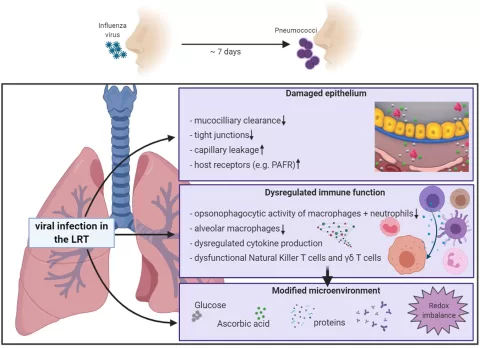Parvovirus B19 neurologic manifestations are an emerging concern within the realm of infectious diseases, especially as recent studies have highlighted their potential impact on mental status and overall neurological health. This small, DNA virus, often known for benign infections such as fifth disease, can infrequently lead to serious neurologic complications, as evidenced by its detection in cerebrospinal fluid during recent outbreaks. Clinicians must be vigilant in identifying symptoms of meningoencephalitis associated with Parvovirus B19 to ensure timely treatment and better patient outcomes. The understanding of these neurologic complications is critical, given that they may occur even among immunocompetent individuals. As we delve deeper into the relationship between Parvovirus B19 and neurological disorders, recognizing these manifestations will be vital for improving diagnosis and intervention strategies.
Understanding the neurologic implications of Parvovirus B19 infection is crucial as it relates to larger themes in viral encephalopathies and related infectious diseases. While typically recognized for causing mild systemic infections, the virus’s potential to contribute to complications like meningoencephalitis underscores the need for further research. Cerebrospinal fluid analysis has become a key tool in diagnosing these rare yet serious presentations, necessitating awareness among healthcare professionals. A nuanced approach to Parvovirus B19 will not only enhance recognition of associated neurologic issues but also improve overall clinical management. As we uncover more about this enigmatic virus, we must remain alert to its broader public health implications.
Understanding Parvovirus B19 and Its Neurologic Complications
Parvovirus B19 is a DNA virus known for its ability to cause various infectious diseases. While traditionally associated with mild symptoms, recent outbreaks have highlighted its potential for severe neurologic complications. These complications can manifest as meningoencephalitis, a condition characterized by inflammation of the brain and the protective membranes surrounding it. Given the rising number of reported cases in recent years, healthcare professionals must remain vigilant in identifying symptoms associated with Parvovirus B19, especially when considering differential diagnoses in patients presenting with neurological symptoms.
The neurologic manifestations of Parvovirus B19 are particularly concerning, as they reveal the virus’s capacity to affect diverse patient populations. In some instances, individuals may present with altered mental status or neurological deficits without concurrent skin manifestations typically seen in other viral infections. This uncharacteristic presentation underscores the need for thorough testing, particularly cerebrospinal fluid analysis during diagnostic evaluations of suspected cases. As more data emerges from studies, including major outbreaks, we gain insight into how Parvovirus B19 operates within the nervous system, indicating potential pathways for targeted therapeutic interventions.
Cerebrospinal Fluid Analysis in Parvovirus B19 Infections
Cerebrospinal fluid (CSF) analysis is critical in diagnosing cases of meningoencephalitis caused by Parvovirus B19. During the recent 2024 outbreak in Madrid, retroactive examinations of CSF samples revealed 6 positive cases among patients suspected of encephalitis. This highlights not only the importance of CSF testing but also the potential for parvovirus to remain undetected in previous diagnostic efforts, given its relatively low positivity rate and the subtlety of symptoms. Accurate and timely analysis allows for prompt intervention, which is fundamental considering the complexities involved in treating viral-related neurologic diseases.
In patients with confirmed Parvovirus B19 in their cerebrospinal fluid, careful clinical assessment becomes paramount. Symptoms may include alterations in consciousness and other cognitive functions, complicating patient management. This requirement emphasizes the necessity for interdisciplinary collaboration among infectious disease specialists, neurologists, and laboratory teams to ensure that CSF results are accurately interpreted, leading to effective patient outcomes. The ongoing research into the mechanisms of neurologic complications associated with Parvovirus B19 may also assist in developing protocols that enhance diagnostic accuracy and treatment efficacy.
Clinical Features and Recovery in Parvovirus B19 Patients
The clinical features observed in patients with neurologic manifestations of Parvovirus B19 vary widely, but early detection is often linked with favorable outcomes. In the collective review from Madrid’s tertiary care center, all identified patients ultimately reached full recovery without significant long-term consequences. Such findings underscore the importance of timely healthcare intervention and the role of healthcare providers in recognizing atypical viral presentations. Although changes in mental status were common, the absence of accompanying skin symptoms suggests that clinicians should maintain a broad perspective when assessing potential Parvovirus B19 cases.
Moreover, the studies indicate that Parvovirus B19 can affect both immunocompetent and immunocompromised individuals, signifying a need to tailor treatment approaches according to patient risk factors. The remarkable recovery of all patients in the study instills a level of optimism regarding management strategies. As awareness and understanding of Parvovirus B19’s neurologic manifestations grow, it becomes increasingly vital for healthcare professionals to disseminate knowledge surrounding the virus to enhance both public awareness and clinical guidelines.
Implications for Infectious Diseases Control and Public Health
The reemergence of Parvovirus B19 as an infectious disease of concern necessitates a robust public health response. Monitoring outbreaks and understanding the epidemiology of the virus is critical for managing its spread effectively. Initiatives aimed at increasing awareness among clinicians can improve early detection, leading to better patient outcomes. Furthermore, as this virus can impact both healthy individuals and those with compromised immune systems, targeted campaigns focused on high-risk groups are essential.
Educational efforts should also emphasize reporting and diagnostic practices for Parvovirus B19 infections, particularly in relation to its neurologic manifestations. By integrating these recommendations into clinical training programs and public health initiatives, the healthcare system can enhance its preparedness for future outbreaks. Ultimately, as we continue to gain insights into Parvovirus B19, developing comprehensive strategies for infection control will be paramount to safeguard public health and optimize patient outcomes.
Research Directions for Parvovirus B19
Given the newly surfaced complexities associated with Parvovirus B19, ongoing research is essential for elucidating its role in neurologic diseases. Future studies should prioritize understanding the pathophysiology of its neurologic manifestations and the interactions between the virus and host immune responses. Insights gained could guide the development of targeted therapies and preventive measures, aiming for effective management of both symptomatic and asymptomatic infections.
Moreover, collaboration among researchers, epidemiologists, and clinicians focuses on creating comprehensive databases and registries that track Parvovirus B19 cases. This wealth of data can facilitate a deeper understanding of its epidemiology, enabling researchers to discern patterns and risk factors associated with severe neurologic complications. In addition, examining the long-term consequences of these complications is equally important in framing the potential impact of Parvovirus B19 infections on public health.
Differential Diagnosis in Meningoencephalitis Cases
In evaluating patients for meningoencephalitis, medical professionals must consider a broad array of potential causative agents, including Parvovirus B19. Given the overlap in symptoms among various viral infections, establishing a definitive diagnosis requires meticulous history-taking, clinical examination, and laboratory investigations, particularly CSF analysis. Understanding the nuances of Parvovirus B19 presentations compared to other infectious agents can aid clinicians in making timely and accurate diagnoses.
The inclusion of Parvovirus B19 in differential diagnosis is crucial, especially as neurological manifestations might not conform to classical presentations. This can lead to delays in treatment and care if overlooked. With the rising incidence of parvovirus infections, especially in certain geographic regions, raising awareness of its neurologic implications will ultimately contribute to more nuanced and effective patient management strategies.
Impact of Parvovirus B19 on Public Awareness
Public awareness campaigns surrounding Parvovirus B19 should aim to educate both healthcare workers and the general public about possible symptoms and consequences of the virus. As evidenced by recent outbreaks, knowledge gaps regarding the virus’s transmission and its potential for causing severe neurologic complications persist. Heightened awareness can lead to quicker medical consultation and intervention, which is key to improving outcomes in infected individuals.
Additionally, integrating educational programs that inform high-risk groups, such as pregnant women and immunocompromised patients, can empower these populations to seek timely evaluations and proper medical care. The combination of public health initiatives with clinical education can foster a more informed society, which is essential for effectively managing this infectious disease.
Future Perspectives on Parvovirus B19 Research
The future of Parvovirus B19 research holds promise, particularly in the realms of vaccine development, diagnostic advancements, and therapeutic options. Continuing to investigate the virus’s interactions with the nervous system could yield insights beneficial for addressing its neurologic manifestations. With the growing understanding of molecular biology and immunology, researchers are better equipped to design inventions that may mitigate complications associated with these infections.
Simultaneously, fostering collaborations across academia and healthcare institutions can accelerate the pace of discoveries related to Parvovirus B19. Research initiatives aimed at clarifying the epidemiological trends and consequences of infections will pave the way for the development of optimized treatment protocols that consider both short-term care needs and long-term health outcomes for affected individuals.
Frequently Asked Questions
What are the neurologic manifestations associated with Parvovirus B19?
Parvovirus B19 can lead to neurologic complications such as changes in mental status and meningoencephalitis. Although these manifestations are rare, they have been documented in several case studies, including a recent review that highlighted the importance of considering Parvovirus B19 in encephalitis diagnoses.
How does Parvovirus B19 affect cerebrospinal fluid in patients with neurologic manifestations?
In patients with neurologic manifestations of Parvovirus B19, the virus can be detected in cerebrospinal fluid (CSF). In a recent study involving 8 patients, Parvovirus B19 was found in CSF samples, indicating its potential role in causing neurologic diseases like meningoencephalitis.
Can Parvovirus B19 lead to severe neurologic complications in immunocompromised patients?
Yes, Parvovirus B19 can cause severe neurologic complications in immunocompromised patients. The virus’s impact on the nervous system, although infrequent, underscores the necessity for clinicians to evaluate patients with neurological symptoms for Parvovirus B19, especially in at-risk populations.
Why is early recognition of Parvovirus B19 neurologic manifestations important?
Early recognition of neurologic manifestations associated with Parvovirus B19 is critical as it allows for timely management, which has been shown to lead to favorable outcomes. Prompt diagnosis can facilitate appropriate treatment and reduce the risk of severe complications.
What clinical features are exhibited by patients with Parvovirus B19 neurologic complications?
Patients with neurologic complications due to Parvovirus B19 may exhibit clinical features such as altered mental status. It is worth noting that in recent cases reported during an outbreak, no skin manifestations were found, highlighting the isolation of neurologic symptoms.
What research is needed to understand Parvovirus B19 neurologic manifestations better?
There is a need for further epidemiological and clinical studies to understand the neurologic manifestations of Parvovirus B19 better. Research should focus on elucidating the underlying mechanisms of these complications to improve diagnostic and therapeutic strategies.
How common are neurologic manifestations in cases of Parvovirus B19 infections?
Neurologic manifestations in Parvovirus B19 infections are quite rare, as indicated by an overall positivity rate of only 0.8% found in a comprehensive study of cerebrospinal fluid samples. This rarity supports the necessity for awareness and consideration of Parvovirus B19 in differential diagnoses of neurologic conditions.
What should clinicians consider when diagnosing encephalitis related to Parvovirus B19?
Clinicians should include Parvovirus B19 in their differential diagnosis when evaluating cases of encephalitis, particularly because the virus can affect both immunocompetent and immunocompromised individuals. Understanding its potential neurologic implications is essential for appropriate patient management.
| Key Point | Details |
|---|---|
| Introduction | Parvovirus B19 reemerges in Spain; 10-year review at a tertiary care center. |
| Neurologic Manifestations | 8 case patients identified with neurologic manifestations in their CSF. |
| Disease Characteristics | Typically asymptomatic or mild but can cause severe conditions in at-risk groups. |
| Study Overview | Retrospective evaluation from 2014 to 2024 indicated a positivity rate of 0.8%. |
| Clinical Outcomes | All patients achieved complete recovery; varied clinical features with mental status changes. |
| Implications for Future Research | Emphasizes need for further studies on the mechanisms and treatment options for parvovirus B19. |
Summary
Parvovirus B19 Neurologic Manifestations are increasingly recognized as critical conditions that require early detection and management. This study from Madrid highlights the rare, but severe, neurological effects associated with parvovirus B19, particularly amid an outbreak. The findings indicate that while parvovirus B19 infections often present mildly, their potential impact on the nervous system, especially in certain populations, warrants further investigation and awareness. Recognizing parvovirus B19 as a differential diagnosis in cases of encephalitis can enhance patient care and outcomes.
The content provided on this blog (e.g., symptom descriptions, health tips, or general advice) is for informational purposes only and is not a substitute for professional medical advice, diagnosis, or treatment. Always seek the guidance of your physician or other qualified healthcare provider with any questions you may have regarding a medical condition. Never disregard professional medical advice or delay seeking it because of something you have read on this website. If you believe you may have a medical emergency, call your doctor or emergency services immediately. Reliance on any information provided by this blog is solely at your own risk.








